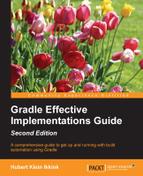In this book, you will find a number of text styles that distinguish between different kinds of information. Here are some examples of these styles and an explanation of their meaning.
Code words in text, database table names, folder names, filenames, file extensions, pathnames, dummy URLs, user input, and Twitter handles are shown as follows: "We can include other contexts through the use of the include directive."
A block of code is set as follows:
task helloWorld << {
println 'Hello world.'
}Any command-line input or output is written as follows:
$ gradle -v ------------------------------------------------------------ Gradle 2.12 ------------------------------------------------------------ Build time: 2016-03-14 08:32:03 UTC Chapter 1 [ 5 ] Build number: none Revision: b29fbb64ad6b068cb3f05f7e40dc670472129bc0 Groovy: 2.4.4 Ant: Apache Ant(TM) version 1.9.3 compiled on December23 2013 JVM: 1.8.0_66 (Oracle Corporation 25.66-b17) OS: Mac OS X 10.11.3 x86_64
New terms and important words are shown in bold. Words that you see on the screen, for example, in menus or dialog boxes, appear in the text like this: "With the Gradle GUI, we have a graphical overview of the tasks in a project and we can execute them by simply clicking on the mouse."
